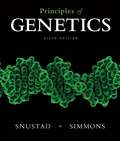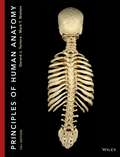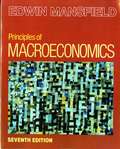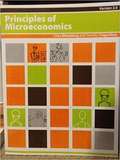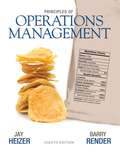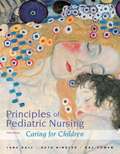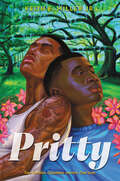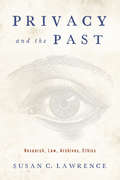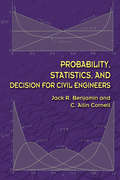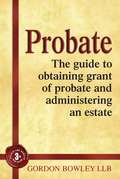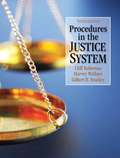- Table View
- List View
Principles of Economics Version 2.0
by Libby Rittenberg Timothy TregarthenIn the macro chapters of Version 2.0 of Principles of Economics thoroughly incorporates the recent recession and recovery-- placing it in historical and theoretical context and not shying away from the controversies surrounding how government responded to it. In the micro chapters, all the time-sensitive data has been updated, along with over half of all the "Start Ups" and "Case and Point" applications being brand new or updated. Flat World Knowledge is thrilled to publish a re-launch of Tim Tregarthen's acclaimed Principles of Economics V. 2.0 book, and proud to bring Tim's remarkable talents as a teacher to future generations of students.
Principles of Economics v 1.1
by Libby Rittenberg Timothy TregarthenVersion 1.1 boasts improved coverage throughout the text including significant updates to: Chapters 20 (GDP, Price Level Changes, Business Cycles, and Unemployment) Chapter 21 (Measuring Total Output and Income) Chapter 27 (Government and Fiscal Policy) Chapter 32 (Macroeconomics for the 21st Century).
Principles of General Chemistry (Second Edition)
by Martin S. SilberbergSilberberg’s Principles of General Chemistry offers students the same authoritative topic coverage as its parent text, Chemistry: The Molecular Nature of Matter and Change. The Principles text allows for succinct coverage of content with minimal emphasis on pedagogic learning aids. This more straightforward approach to learning appeals to today’s efficiency-minded, value-conscious instructors and students without sacrificing depth, clarity, or rigor.
Principles of Genetics (Sixth Edition)
by D. Peter Snustad Michael J. SimmonsSnustad's 6th edition of Principles of Genetics offers many new and advanced features including boxed sections with the latest advances in Genetics, a streamlined roster of topics, a more reader-friendly layout, and new problem-solving supplements. Furthermore, this new edition includes more problem solving within each chapter through the Test Your Problem Solving Skills feature and a Solve It icon to prompt readers to go online to WileyPlus for animated tutorials. A new one-column design better showcases important pieces of art and avoids the "overwhelmed" reaction readers have to the crowded layouts found in many other texts. Boxed sections reduce in size to help maintain the flow of the text and the Focus On boxes are revised to include the most current developments in genetics as well as most relevant topics.
Principles of Geoarchaeology: A North American Perspective
by Michael R. WatersPresents the basics of geoarchaeology, through application of field techniques to a study of the late Quaternary of America. Alluvial, terrestrial and coastal environments are considered, as well as post burial physical disturbances of archaeological sites.
Principles of Group Solidarity
by Michael HechterSocial scientists have long recognized that solidarity is essential for such phenomena as social order, class, and ethnic consciousness, and the provision of collective goods. In presenting a new general theory of group solidarity, Michael Hechter here contends that it is indeed possible to build a theory of solidarity based on the action of rational individuals and in doing so he goes beyond the timeworn disciplinary boundaries separating the various social sciences.
Principles of Human Anatomy
by Gerard J. Tortora Mark T. NielsenA market-leading text through its many editions, the 13th edition of Principles of Human Anatomy continues to successfully blend visual and textual elements to illuminate the complexities of human anatomy. Written for the 1-term human anatomy course, the 13th edition raises the standard for excellence in this discipline with its enhanced illustration program, refined narrative, and the integrated design of dynamic resources like Real Anatomy 2. 0 into the curriculum.
Principles of Macroeconomics
by Edwin MansfieldStudents will appreciate the accompanying Study Guide, prepared by Professor Mansfield himself. It contains Chapter Profiles, behavioral Objectives, Case Studies, Objective Questions, Discussion Questions, and Problems for each chapter in the textbook. A separate Computerized Study Guide with approximately 200 review questions and diagrams is also available.
Principles of Macroeconomics
by Libby Rittenberg Timothy TregarthenFlat World Knowledge is honored to publish a new, first edition re-launch of Tim Tregarthen's wonderful principles of macroeconomics book, and proud to bring Tim's incredible talents as a teacher back to life so future generations of students can continue to learn from him. In 1996, he published the first edition of his principles of microeconomics textbook to great acclaim, and it became widely used in colleges around the country. That same year, MS made him wheelchair-bound. The disease forced his retirement from teaching at the University of Colorado at Colorado Springs in 1998. He lost the use of his arms in 2001 and has been quadriplegic ever since. Tim never let his disease get him down. In fact, he turned back to his love of writing and teaching for inspiration. He obtained a voice-activated computer, recruited a co-author, Libby Rittenberg of Colorado College, and turned his attention to revising his principles of economics book. Today we are excited to introduce Libby Rittenberg and Timothy Tregarthen's Principles of Macroeconomics. The authors teach economics as the study of "choice " by providing students with an accessible, straightforward overview of economics. This text combines the clarity and writing of Tregarthen's seminal periodical "The Margin" with great teaching insights. Rittenberg and Tregarthen help students to understand how real individuals actually work with economics. In this new book, the authors illustrate the practicality and relevance of economics with a variety of new illustrations and insights. The authors take a three-pronged approach to every concept: (1) the concept is covered with a "Heads Up" to ward off confusion, (2) a "You Try It" section makes sure students are staying on top of the concept and (3) a "Case and Point" section that uses a real-world application to harness the concept in reality. For one example of how this plays out in the text see "Chapter 3, Section 2 on Supply".here This book is intended for a one-semester course in Macroeconomics taught out the social sciences or business school.
Principles of Macroeconomics (Eleventh Edition)
by Ray C. Fair Karl E. Case Sharon OsterCollege economics textbook.
Principles of Management
by Talya Bauer Mason Carpenter Berrin ErdoganPrinciples of Management by Carpenter, Bauer and Erdogan teaches management principles to tomorrow's business leaders by weaving three threads through every chapter: strategy, entrepreneurship and active leadership. Strategic: All business school teachings have some orientation toward performance and strategy and are concerned with making choices that lead to high performance. Principles of Management will frame performance using the notion of the triple bottom-line the idea that economic performance allows individuals and organizations to perform positively in social and environmental ways as well. The triple bottom line is financial, social, and environmental performance. It is important for all students to understand the interdependence of these three facets of organizational performance. The Entrepreneurial Manager: While the General Management course at Harvard Business School was historically one of its most popular and impactful courses (pioneered in the 1960s by Joe Bower), recent Harvard MBAs did not see themselves as general managers. This course was relabeled 'The Entrepreneurial Manager' in 2006, and has regained its title as one of the most popular courses. This reflects and underlying and growing trend that students, including the undergraduates this book targets, can see themselves as entrepreneurs and active change agents, but not just as managers. By starting fresh with an entrepreneurial/change management orientation, this text provides an exciting perspective on the art of management that students can relate to. At the same time, this perspective is as relevant to existing for-profit organizations (in the form intrapreneurship) as it is to not-for-profits and new entrepreneurial ventures. Active Leadership: Starting with the opening chapter, Principles of Management show students how leaders and leadership are essential to personal and organizational effectiveness and effective organizational change. Students are increasingly active as leaders at an early age, and are sometimes painfully aware of the leadership failings they see in public and private organizations. It is the leader and leadership that combine the principles of management (the artist's palette, tools, and techniques) to create the art of management. Cases: Mason provides brief cases in his Instructors Manual for those who take a case approach to the course or who wish to incorporate cases. This book's modular format easily maps to a POLC course organization (Planning, Organizing, Leading, and Controlling, attributed to Henri Fayol (1949, General and industrial management. London. Pitman Publishing company), and suits the needs of most undergraduate or graduate course in Principles of Management.
Principles of Marketing 2.0
by Jeff Tanner Mary Anne RaymondPrinciples of Marketing Version 2.0 by Tanner, Raymond and Schuster teaches the experience and process of actually doing marketing - not just the vocabulary. It carries five dominant themes throughout in order to expose students to marketing in today's environment: Service dominant logic - This textbook employs the term "offering" instead of the more traditional First "P" -- product. That is because consumers don't sacrifice value when alternating between a product and a service. They are evaluating the entire experience, whether they interact with a product, a service, or a combination. So the fundamental focus is providing value throughout the value chain, whether that value chain encompasses a product, service, or both. Sustainability; Increasingly, companies are interested in the impact they are having on their local community as well as the overall environment. This is often referred to as the triple bottom line of financial, social, and environment performance. Ethics and social responsibility; Following on the sustainability notion is the broader importance of ethics and social responsibility in creating successful organizations. The authors make consistent references to ethical situations throughout chapter coverage, and end of chapter material in most chapters will encompass ethical situations. Global coverage -- Tanner, Raymond and Schuster deliberately entitled Chapter 1; What is Marketing?; Whether it is today's price of gasoline, the current U.S. presidential race, or Midwestern U.S. farming, almost every industry and company needs strong global awareness. And today's marketing professionals must understand the world in which they and their companies operate. Metrics -- Firms today have the potential to gather more information than ever before about their current and potential customers. That information gathering can be costly, but it can also be very revealing. With the potential to capture so much more detail about micro transactions, firms should now be more able to answer ;well, what this marketing strategy really worth it?; And what is the marketing ROI?; And finally, what is this customer or set of customers worth to us over their lifetime? Principles of Marketing Version 2.0 brings new and updated coverage of new developments in the influence of social media to empower consumers, as well as marketing's use of social media, such as sentiment analysis, mobile marketing, and customer service and complaint tracking, as a communications and promotion channel, just a name a few. Version 2.0 also has an overall increased number of examples, as well as, new discussion questions in every chapter (resulting in at least 10 per chapter). In addition, the textbook's key terms, and repeated concepts have been strategically arranged to make customizing this book with Flat World's MIYO platform even easier.
Principles of Microeconomics (2nd Edition)
by Timothy TaylorA textbook that is rooted to help students perform well in introductory economics and acquire the basic tools to deal with economics.
Principles of Microeconomics 2.0
by Libby Rittenberg Timothy TregarthenFlat World Knowledge is honored to publish Version 2.0 (an orginal re-launch) of Tim Tregarthen's wonderful principles of microeconomics book, and proud to bring Tim's incredible talents as a teacher back to life so future generations of students can continue to learn from him.
Principles of Operations Management (Eighth Edition)
by Jay Heizer Barry RenderThis book presents a state-of-the- art view of the activities of the operations function. This book will also help you understand how OM affects society and your life.
Principles of Pediatric Nursing: Caring for Children (Fifth Edition)
by Jane W. Ball Ruth C. Bindler Kay J. CowenThe goal of the fifth edition of this textbook is to provide core pediatric nursing knowledge that prepares students for excellence in nursing, and to offer the tools of scholarship and critical thinking required during practice.
Principles of Sedimentology and Stratigraphy (Fifth Edition)
by Sam BoggsThis concise treatment of the fundamental principles of sedimentology and stratigraphy highlights the important physical, chemical, biological, and stratigraphic characteristics of sedimentary rocks. It emphasizes the ways in which the study of sedimentary rocks is used to interpret depositional environments, changes in ancient sea level, and other intriguing aspects of Earth's history.
Pritty
by Keith F. Miller, Jr.Concrete Rose meets Things We Couldn’t Say in Pritty, a debut novel by Keith F. Miller Jr.—the inspiration behind the forthcoming animated short film of Kickstarter fame—that follows two boys who get caught in the crossfire of a sinister plot that not only threatens everything they love but may cost them their own chance at love. On the verge of summer before his senior year, Jay is a soft soul in a world of concrete. While his older brother is everything people expect a man to be—tough, athletic, and in charge—Jay simply blends into the background to everyone, except when it comes to Leroy.Unsure of what he could have possibly done to catch the eye of the boy who could easily have anyone he wants, Jay isn’t about to ignore the surprising but welcome attention. But as everything in his world begins to heat up, especially with Leroy, whispered rumors over the murder of a young Black journalist and long-brewing territory tensions hang like a dark cloud over his neighborhood. And when Jay and Leroy find themselves caught in the crossfire, Leroy isn’t willing to be the reason Jay’s life is at risk.Dragged into the world of the Black Diamonds—whose work to protect the Black neighborhoods of Savannah began with his father and now falls to his older brother—Leroy knows that finding out who attacked his brother is not only the key to protecting everyone he loves but also the only way he can ever be with Jay. Wading through a murky history of family trauma and regret, Leroy soon discovers that there’s no keeping Jay safe when Jay’s own family is in just as deep and fighting the undertow of danger just as hard.Now Jay and Leroy must puzzle through secrets hiding in plain sight and scramble to uncover who is determined to eliminate the Black Diamonds before someone else gets hurt—even if the cost might be their own electric connection.
Privacy and the Past: Research, Law, Archives, Ethics
by Susan C. LawrenceWhen the new HIPAA privacy rules regarding the release of health information took effect, medical historians suddenly faced a raft of new ethical and legal challenges--even in cases where their subjects had died years, or even a century, earlier. In Privacy and the Past, medical historian Susan C. Lawrence explores the impact of these new privacy rules, offering insight into what historians should do when they research, write about, and name real people in their work. Lawrence offers a wide-ranging and informative discussion of the many issues involved. She highlights the key points in research ethics that can affect historians, including their ethical obligations to their research subjects, both living and dead, and she reviews the range of federal laws that protect various kinds of information. The book discusses how the courts have dealt with privacy in contexts relevant to historians, including a case in which a historian was actually sued for a privacy violation. Lawrence also questions who gets to decide what is revealed and what is kept hidden in decades-old records, and she examines the privacy issues that archivists consider when acquiring records and allowing researchers to use them. She looks at how demands to maintain individual privacy both protect and erase the identities of people whose stories make up the historical record, discussing decisions that historians have made to conceal identities that they believed needed to be protected. Finally, she encourages historians to vigorously resist any expansion of regulatory language that extends privacy protections to the dead. Engagingly written and powerfully argued, Privacy and the Past is an important first step in preventing privacy regulations from affecting the historical record and the ways that historians write history.
Proactive Parenting: Help your child conquer self-destructive behaviours and build self-esteem
by Mandy SaligariTake a proactive approach towards your child's mental health and discover how to have the conversations that will be life-saving and life-changing.With a foreword by Benny Refson, President of the children's mental health charity Place2BeThe pressures faced by children and adolescents today are unprecedented, and the corresponding statistics around poor mental health deeply alarming. Behind every mental health issue, from addiction to ADHD, lies a host of underlying problems that need addressing but as a worried parent it's hard to know where to focus. What do you do if your child struggles with anxiety? Is self-harming? Has developed an unhealthy relationship with eating, exercise, technology or alcohol?Proactive in approach, top addiction therapist Mandy Saligari provides the tools to help you identify and address the self-destructive patterns of behaviour, to stop them in their tracks. Her practical framework reveals how you can adapt your own behaviour and equip your child to develop emotional intelligence, resilience and self-esteem.
Probability, Statistics, and Decision for Civil Engineers (Dover Books on Engineering)
by Jack R Benjamin C. Allin CornellDesigned as a primary text for civil engineering courses, as a supplementary text for courses in other areas, or for self-study by practicing engineers, this text covers the development of decision theory and the applications of probability within the field. Extensive use of examples and illustrations helps readers develop an in-depth appreciation for the theory's applications, which include strength of materials, soil mechanics, construction planning, and water-resource design. A focus on fundamentals includes such subjects as Bayesian statistical decision theory, subjective probability, and utility theory. This makes the material accessible to engineers trained in classical statistics and also provides a brief elementary introduction to probability. The coverage also addresses in detail the methods for analyzing engineering economic decisions in the face of uncertainty. An Appendix of tables makes this volume particularly useful as a reference text.
Probate: A Self-help Guide
by Gordon BowleyThe majority of applications for probate that follow someone's death can be dealt with inexpensively by any reasonably intelligent person with time available and a little guidance. This easy-to-follow book clearly explains all the information you need to administer the deceased's estate; from dealing with the urgent practical matters to preparing and submitting the relevant forms, paying inheritance tax, and distributing the estate. You'll find specimen forms and letters and a list of useful addresses that will enable you to deal with it all yourself.
Problems of Knowledge: A Critical Introduction to Epistemology
by Michael WilliamsProblems of Knowledge provides clear and engaging explanations of the theory of knowledge and why it matters, offering an excellent foundation for students in introductory epistemology courses.
Procedures in the Justice System (10th Edition)
by Cliff Roberson Harvey WallaceProcedures in the Justice System, 10e, is comprehensive yet readable. Designed for one-semester courses on American criminal courts, it covers the court systems and processes using a sequential approach-following law violators from arrest to conviction and sentencing. Each chapter examines the roles that law enforcement agencies, courts, and correctional departments play in the process, and builds logically on previous material. Down-to-earth examples, illustrations, court documents, and cases help make procedures more real and concrete.
Processing: A Programming Handbook for Visual Designers and Artists
by Ben Fry John Maeda Casey ReasAn introduction to the ideas of computer programming within the context of the visual arts that also serves as a reference and text for Processing, an open-source programming language designed for creating images, animation, and interactivity.



